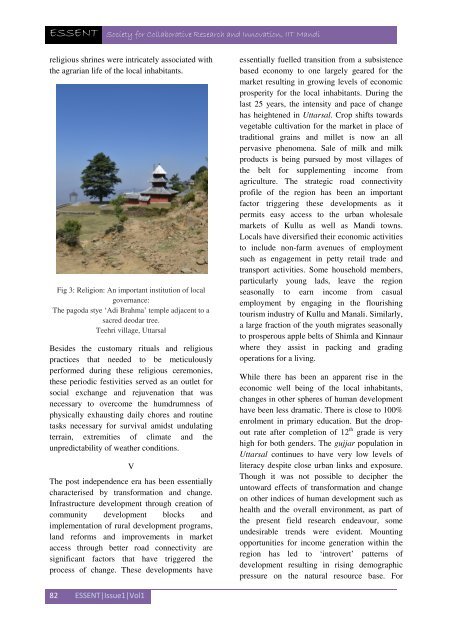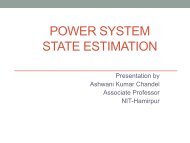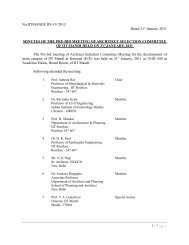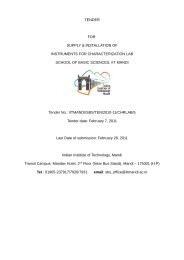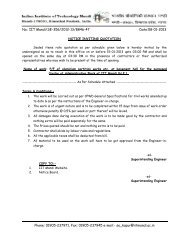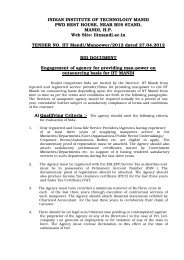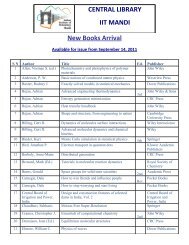ESSENT Society for Collaborative Research and Innovation, <strong>IIT</strong> <strong>Mandi</strong>religious shrines were intricately associated withthe agrarian life of the local inhabitants.Fig 3: Religion: An important institution of localgovernance:The pagoda stye ‘Adi Brahma’ temple adjacent to asacred deodar tree.Teehri village, UttarsalBesides the customary rituals and religiouspractices that needed to be meticulouslyperformed during these religious ceremonies,these periodic festivities served as an outlet forsocial exchange and rejuvenation that wasnecessary to overcome the humdrumness ofphysically exhausting daily chores and routinetasks necessary for survival amidst undulatingterrain, extremities of climate and theunpredictability of weather conditions.VThe post independence era has been essentiallycharacterised by transformation and change.Infrastructure development through creation ofcommunity development blocks andimplementation of rural development programs,land reforms and improvements in marketaccess through better road connectivity aresignificant factors that have triggered theprocess of change. These developments haveessentially fuelled transition from a subsistencebased economy to one largely geared for themarket resulting in growing levels of economicprosperity for the local inhabitants. During thelast 25 years, the intensity and pace of changehas heightened in Uttarsal. Crop shifts towardsvegetable cultivation for the market in place oftraditional grains and millet is now an allpervasive phenomena. Sale of milk and milkproducts is being pursued by most villages ofthe belt for supplementing income fromagriculture. The strategic road connectivityprofile of the region has been an importantfactor triggering these developments as itpermits easy access to the urban wholesalemarkets of Kullu as well as <strong>Mandi</strong> towns.Locals have diversified their economic activitiesto include non-farm avenues of employmentsuch as engagement in petty retail trade andtransport activities. Some household members,particularly young lads, leave the regionseasonally to earn income from casualemployment by engaging in the flourishingtourism industry of Kullu and Manali. Similarly,a large fraction of the youth migrates seasonallyto prosperous apple belts of Shimla and Kinnaurwhere they assist in packing and gradingoperations for a living.While there has been an apparent rise in theeconomic well being of the local inhabitants,changes in other spheres of human developmenthave been less dramatic. There is close to 100%enrolment in primary education. But the dropoutrate after completion of 12 th grade is veryhigh for both genders. The gujjar population inUttarsal continues to have very low levels ofliteracy despite close urban links and exposure.Though it was not possible to decipher theuntoward effects of transformation and changeon other indices of human development such ashealth and the overall environment, as part ofthe present field research endeavour, someundesirable trends were evident. Mountingopportunities for income generation within theregion has led to ‘introvert’ patterns ofdevelopment resulting in rising demographicpressure on the natural resource base. For82 ESSENT|Issue1|Vol1
ESSENT Society for Collaborative Research and Innovation, <strong>IIT</strong> <strong>Mandi</strong>instance, energy requirements for cooking andheating during winter continue to be largelydependent on firewood from forests. Despitebetter road access and distribution mechanisms,only 15% of the households have LPGownership because of lack of affordability. Eventhose who own cylinders conserve the resourceas it is expensive. Rising numbers haveaggravated the problem leading to unsustainablepressure on forest resources. Lopping forfirewood could have dire consequences for thestanding tree-stock in the forests and the ecosystemthese nurture.In the socio-cultural realm, perhaps traditioncontinues to have a predominant sway overpeople’s lives in comparison to modernity. Butthe scales seem to be tilting towards the otherextreme, undermining local art forms,indigenous technology and architecture, diet anddialect, thereby endangering the cultural identityof these highland inhabitants. Field impressionsrevealed that urbanity and urban sensibilitieshave started permeating various spheres of localexistence. The development of ‘Kamand’campus in the heart of Uttarsal is unlikely to bea benign stimulus amidst an already buoyantscenario of transition and change. Perceptionsof change have already permeated the mindsetof the local community. Oral testimoniesgathered in course of field studies reiteratedeconomic gains that would be forthcoming dueto the coming up of the campus. The localshowever could not envisage any kind ofbeneficial social externalities that couldpotentially emanate from an educationalinstitute of premier learning. They felt that thecampus would survive as an ‘encapsulated’entity.VIMy brief sojourn opened up a myriad ofexperiential avenues for comprehending aregion and its historical context, its socioculturalattributes, its natural resourceendowments and its changing socio-ecologicalprofile. In course of my field studies inHimachal and my periodic visits and re-visits, Ihave been deeply concerned about theunplanned and haphazard nature of land usechanges that are occurring because of expandinghighways, hydro-electric projects, emergingtowns and a host of educational institutions.While these ventures are an outcome of the needto cater to regional or national developmentgoals, the effects on the social and naturalenvironments has not always been desirable.This is of particular relevance for a mountainState that is ecologically fragile and is inhabitedby human populations steeped in traditionwherein lifestyles continue to be intricatelyassociated with the natural resource base. Theseland use changes have also started threateningand fragmenting wild life flora and fauna habitatsome of which are endemic. While developmentcannot be shunned away, the process can beguided and directed to cause minimum damageto the environment. By unravelling a rich socioecologicalcontext, I do hope that my report willfacilitate the ex-ante planning of better longterm outcomes as regards the upcoming‘Kamand’ campus and thereby set a newprecedent for sustainable land use changes in theState.I am extremely grateful to <strong>IIT</strong> <strong>Mandi</strong> for hostingme in course of my field studies. This report isdedicated to the faculty, students and staff of theInstitute. A special note of thanks goes out to‘Ankit’. In response to my excited andgesticulated verbal ‘first’ accounts of Uttarsal,he suggested that I should write.References:1) Berremen, G.D. (1963): ‘People andCultures of the Himalayas’, Asian Survey,Vol.3, No.6, June.2) Berreman, G.D. (1999): ‘Hindus of theHimalayas’, Oxford University Press,N.Delhi.3) Census of India (1991): ‘District CensusHandbook: <strong>Mandi</strong>’4) Epstein, T.S., Suryanarayana, A.P. &Thimmegowda, T. (2002): ‘Village Voices.83 ESSENT|Issue1|Vol1


